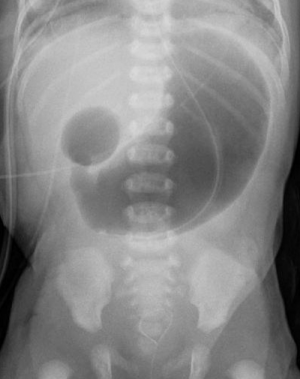Duodenal atresia
Background
- During weeks 6 and 7 of gestation, the GI tract becomes occluded then recanalizes during weeks 8 to 10
- Duodenal atresia is thought to result from failure of recanalization
- Often associated with other malformations such as biliary atresia or gallbladder agenesis
- May also be associated with cardiac, renal, or vertebral abnormalities
- About a quarter of patients born with duodenal atresia have Down syndrome
Clinical Features
Presentation is very early in the postnatal period
- Abdominal distention and bilious emesis within first 24 hours of birth
- Abdomen often markedly distended, with visible or palpable loops of bowel
- NG tube aspirate >20 mL
- Signs of dehydration (e.g. dry mucous membranes, poor skin turgor, and sunken fontanelle)
- +/- Signs of other congenital anomalies
Differential Diagnosis
- Malrotation with volvulus
- Hirschsprung's disease
- Meconium ileus
- Other intestinal atresia
Nausea and vomiting (newborn)
| Newborn | ' |
| Obstructive intestinal anomalies |
|
| Neurologic |
|
| Renal |
|
| Infectious | |
| Metabolic/endocrine | |
| Miscellaneous |
|
Evaluation

Double Bubble sign
- Imaging
- AP, lateral, and cross table XR should be obtained on all infants with concern for obstruction
- Classic double bubble sign due to dilation of the stomach and proximal duodenum
- Absent distal gas
Management
- NPO
- NG tube to suction
- Correct fluid and electrolyte abnormalities
- Ampicillin and gentamicin (to prevent post-op infection)
- Surgery
Disposition
- Admission
References
This article is issued from
Wikem.
The text is licensed under Creative
Commons - Attribution - Sharealike.
Additional terms may apply for the media files.